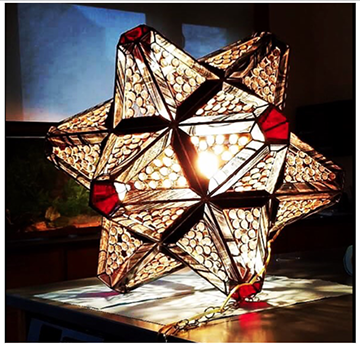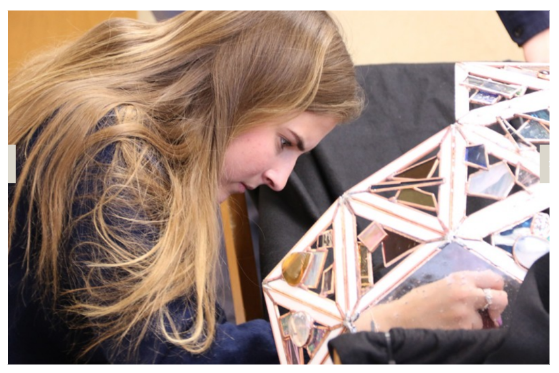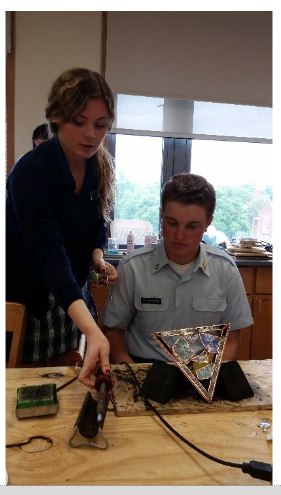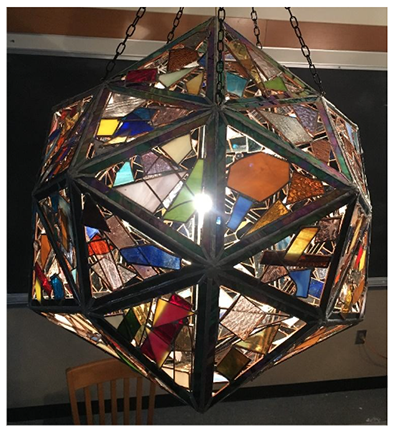Sandy Reavill, Culver, IN, sandrareavill@cpm.org
What do you get when you put 76 CPM students in a room for three days with 720 beads, 540 feet of copper foil, 120 congruent edges, 120 parallel edges, 60 isosceles triangles, ten pounds of solder, nine soldering irons, three CPM teachers, one mathematical artist, and a light bulb?

The Dis-Appointed Small Stellated Dodecahedron!
…and countless opportunities for learning. This has been the scene during the last week of Geometry class every semester at Culver Academies for the past five years. I met mathematical artist Hans Schepker ten years ago at the New Hampshire Artisans Fair near his home and was mesmerized by his booth. It was a perfect summer afternoon and I was strolling through the fairgrounds at Mt. Sunapee. Absentmindedly thinking about spring skiing and browsing for cool earrings or the perfect salad bowl, I came upon a zoo of geometric figures hanging in a corner booth. There was a pair of intersecting cubes hanging above the collection, shedding blue and red light over a vast array of colorful polyhedral sculptures, many fashioned into chandeliers. The precision of the work was amazing. A group of fairgoers who had gathered around the proprietor were gazing into a glass cube that appeared to suspend a fourth dimensional hyper-cube, and throwing out ideas about how this illusion was possible. The group was so engaged with the mathematical structure of the piece, I knew I was witnessing an amazing learning experience. As I strolled through the fair that day, my thoughts kept returning to Hans’s work and the words of Dr. Dennis Littky from Big Picture Learning who encouraged me to invite experts into my classroom. “I’ve never met a professional who wasn’t willing to share their passion with kids – all ya’ gotta’ do is ask ‘em!” Littky would proclaim at conferences. I made my way back to the booth with the whimsical banner that read “Mathematically Correct Lighting,” asked, “Would you consider an Artist in Residence?” and this classroom partnership (Video) began.
Twice a year for the past five years, Hans has loaded up his Mini Cooper with the tools of his trade and the parts for a geometric glass sculpture, and begun the drive across the country to meet my students. Around the time he leaves New Hampshire, I start converting a science lab into an artist’s studio; I cover the school desks with plywood to protect them from the heat of the soldering irons, I replace the new plastic chairs with the old wooden ones, and I set aside the anatomical models and bring out the mathematical ones. On the first day of the workshop, I introduce my students by class, up to 40 per block period, to Hans and their new roles as ‘Geometric Artists.’ Over the years, Hans and I have leveraged the training my students receive in the CPM roles in order to maximize ownership of the success of the project.


Throughout the term, my students have several assessment opportunities that characterize roles specific to a profession or historical context. For example, during Unit 4, they become naval officers for the team-based scavenger hunt trigonometry assessment called The Sub-Station Challenge. For Unit 11, they become Manor Lords to work through a solids assessment called The Castle Challenge and the day before the Glass Geometry Workshop begins, they are Calibration Technicians for a teaching opportunity called the Pull Up a Chair Geometry Fair. When they arrive for the Workshop, they start reading their responsibilities as Geometric Artists and they realize that now they each take responsibility over all aspects of the project. The idea is in harmony with the result that understanding is owned by all students at the end of the course.
During the workshop, students focus on accuracy and precision while foiling the glass parts that go into the professional-quality sculpture. They also look for and express repeated reasoning when they solder the trapezoidal faces, then pentagonal pyramids of the polyhedral as the piece grows. Students analyze errors and amend misconceptions when they must remove upside down faces from completed portions of the sculpture, and in the evenings, they reason both abstractly and quantitatively as they construct viable arguments for the measurements that are held within the structure of the space. Collaboration is high as each class leaves their station ready for the next block period, and each component of the sculpture is handled by several students on its way to final assembly day.
I do not try to link the glass geometry learning directly back to a content strand. What is important to me is that my students work side by side with a passionate mathematics professional who gives them the opportunity to model with mathematics in a beautiful way with a group of their very best friends. I am confident that the experience of the workshop creates an increased ability to hold a mathematical idea in mind… and gives them a reason to want to! We call these phenomena, “Going all Paul Lockhart on it!” (Video)
Sustainability is also highlghted in the workshop. Students practice careful counting procedures earlier in the term when they must order paper strips to build one of Heinz Strobl’s Snapology models accurately. We keep small ziplock waste bag on each station throughout the three-day workshop so that we can see what is thrown away. The project even funds itself; the completed chandeliers are auctioned off in order to fund the next workshop. Student work, guided by Hans Schepker, is hanging proudly in the homes of four “friends of the Academy” who have purchased chandeliers, and two were purchased by an alumna and donated back to the school where they hang proudly in the Dicke Hall of Mathematics.
Sandy Reavill, Senior Instructor at Culver Academies in Culver, IN is a CPM teacher and classroom researcher with TRC 3.0. She will be presenting at the CPM Teachers Conference in February on two topics, Test Wrappers – How to Facilitate Re-Thinking Through Re-Working and The Recorder’s Outline, a Student Accountability Tool for Teaching CPM in the Block Schedule.


